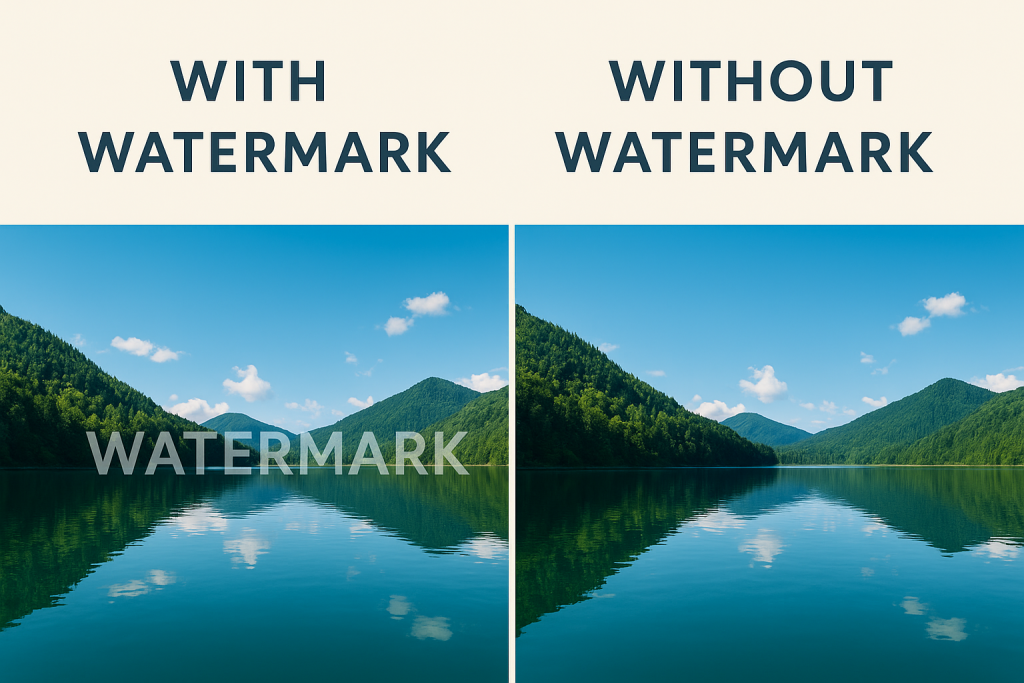Last Updated on November 5, 2025 by gaojie
In the age of digital sharing, millions of photos are uploaded online every day — from personal snapshots to professional images used by brands and creators. With so much visual content floating across social media, blogs, and marketplaces, protecting your photos has become a serious challenge.
One simple, effective solution is the watermark — a recognizable mark placed over your image to show ownership or identity. But when you search for pictures of watermarks online, you’ll notice something interesting: not all watermarks look good. Some appear elegant and professional, while others are distracting or poorly placed.
In this guide, we’ll explore everything you need to know about watermarked images — from their purpose and design principles to real examples, AI-era challenges, and the tools that can help you manage them. Whether you’re a beginner photographer, a blogger, or a small business owner, you’ll learn how to make your images both beautiful and secure.
1. What Are Pictures of Watermarks?
“Pictures of watermarks” simply refers to images that contain visible marks or logos indicating ownership, authorship, or brand identity. A watermark can be a signature, a logo, a name, or even a pattern that overlays the image.
For example, when photographers share their portfolio online, they often include a small logo in the corner. When stock photo sites upload previews, they usually add a large diagonal watermark across the center to prevent unauthorized use.
These are all pictures of watermarks — photos that carry a protective or promotional mark.
The core purpose of watermarks can be summarized in three main points:
- Protection — discourage image theft or misuse.
- Attribution — let viewers know who created or owns the image.
- Branding — reinforce recognition across your visual content.
A well-designed watermark acts like a signature — subtle but unmistakable. It signals professionalism and ownership without ruining the visual impact.
2. Why Watermarks Matter in the Digital World
Images travel fast online. Once a photo is posted on social media or shared in a public gallery, it can easily be downloaded, screenshotted, or reposted without permission. Even search engines display thumbnails that can be reused elsewhere.
That’s why creators use watermarks — not to completely prevent theft, but to make unauthorized use less appealing. A visible logo or name tells people that the image belongs to someone, adding a psychological barrier against misuse.
However, watermarks are not just about “protection.” They’re also a way to build identity. A consistent watermark on all your pictures strengthens brand recall. When people see your logo, they instantly associate it with your style or business.
For instance, wedding photographers often use elegant cursive signatures; travel influencers might use a small transparent logo; companies might watermark all their marketing visuals for brand consistency.
The goal is to balance visibility and subtlety — enough to identify you, but not so much that it distracts viewers.

3. Common Types of Watermarks (with Examples)
When exploring pictures of watermarks online, you’ll come across various styles. Each serves a specific purpose and suits different needs. Below is a breakdown of the most popular types and where they work best.
| Type | Description | Common Use | Visual Example |
| Text Watermark | Plain text (e.g., name or website) placed in a corner; usually semi-transparent. | Personal blogs, photo portfolios. | Photographer signature |
| Logo Watermark | Small logo or icon overlay; consistent across all images. | Businesses, brands, eCommerce. | Brand logo in bottom corner |
| Pattern Watermark | Repeated mark covering the entire photo diagonally. | Stock image previews. | Diagonal “Sample” text |
| Invisible Watermark | Embedded metadata or digital signature not visible to the eye. | Copyright tracking and AI protection. | Hidden digital tag |
| Central Overlay Watermark | Large, opaque mark across the middle of the image. | Proofs, demos, or non-final designs. | “Preview Only” across center |
Each type of watermark balances aesthetics and security differently.
If your goal is brand awareness, a visible logo in the same place on every image works best.
If your goal is protection from theft, a repeated pattern watermark offers more safety.
4. How to Add a Watermark to Your Images
You don’t need to be a professional designer to create a good watermark. Many free and paid tools let you add custom watermarks to your photos in minutes.
Step 1: Choose Your Mark
Decide what to use — text (your name, site, or slogan) or an image logo. Use a transparent PNG for a cleaner effect.
Step 2: Pick a Tool
Here are a few easy methods:
- Desktop software: Photoshop, Lightroom, or GIMP.
- Mobile apps: Snapseed, Canva, or Add Watermark.
- Online tools: Websites that allow batch watermarking directly in the browser.
Step 3: Adjust Style and Placement
- Transparency: around 40–60% opacity works best.
- Font: simple and readable (avoid fancy scripts unless it fits your brand).
- Position: bottom right or top left corner.
Step 4: Save and Test
Export your image in high quality and check if the watermark looks clear but not intrusive on different screens.
5. Removing Unwanted Watermarks (When It’s Legal)
Sometimes, you might have your own image but only the watermarked version left — for example, an old project or an image with a misplaced mark. In such cases, removing a watermark is acceptable as long as you are the rightful owner.
AI-powered tools like the Gstory Photo Watermark Remover make this process simple. The tool automatically detects watermarks, removes them cleanly, and fills in the background naturally — saving you hours of manual editing.
It’s especially useful for restoring old digital photos, rebranding visual assets, or correcting design mistakes.
⚠️ Important Note: You should never remove watermarks from images that you don’t own. This violates copyright laws and can harm your online reputation. Always respect other creators’ work.
6. Choosing the Best Watermark for Your Needs
Different situations require different watermark styles. Here’s how to choose wisely:
For Photographers
Use small, elegant watermarks that complement your art. Avoid covering the main subject.
For Bloggers and Content Creators
Include your website or brand name. It helps people trace the original source when your image is shared.
For Businesses and eCommerce Stores
Use clear, professional logo watermarks. Keep them consistent across all platforms to build brand trust.
For Social Media
Go minimal — small transparent logos that don’t block faces or products. Consistency across posts helps viewers recognize your brand faster.
For Designers and Artists
Consider combining a visible watermark with hidden metadata or blockchain-based ownership tags for extra protection.
7. Common Mistakes When Using Watermarks
Even though watermarks are simple in concept, many creators make mistakes that weaken their impact or make images look unprofessional. Here are the most frequent errors:
- Overly large watermarks — dominate the image, making it unattractive.
- Too transparent — invisible to the human eye, defeating the purpose.
- Inconsistent placement — moving watermarks in every image breaks visual identity.
- Distracting fonts or colors — red or neon fonts can look cheap.
- Low-resolution logos — blurred watermarks look unprofessional.
A good rule of thumb: if your watermark is the first thing viewers notice, it’s too strong.

8. The Evolution of Watermarks: From Print to AI Era
Watermarks have a surprisingly long history. They first appeared in paper manufacturing in the 13th century as translucent marks embedded in paper pulp to identify makers.
In the digital age, the concept evolved into graphic overlays for photos. But as technology advanced, so did image editing. Modern AI tools can now remove watermarks automatically — even complex ones — raising new questions about image security.
That’s why digital creators today use hybrid protection: visible watermarks for human viewers and invisible signatures for AI and copyright detection.
As artificial intelligence continues to evolve, watermarks might become “smart” — embedded into the pixels in ways invisible to the naked eye but readable by machines.
9. Ethical Use of Watermarks
Watermarks should never be used to claim ownership of content that isn’t yours. Similarly, removing someone else’s watermark — even for “personal use” — can violate copyright laws.
Always follow these principles:
- Only watermark your own work or licensed content.
- Never remove or edit watermarks on others’ photos.
- When using AI tools like Gstory Photo Watermark Remover, ensure it’s for your own material.
Following ethical guidelines builds trust with your audience and helps maintain a healthy creative community.
10. Case Study: How a Small Brand Improved Its Visual Identity
Let’s take an example. “BreeLight Photography,” a small travel photography brand, noticed that other pages often reposted their images without credit. They started adding a subtle semi-transparent logo in the bottom right corner of every photo.
Within three months:
- Website traffic increased by 30%.
- Google image searches started showing their brand consistently.
- Unauthorized reposts decreased because the watermark made ownership clear.
The takeaway? A good watermark is not just protection — it’s free branding.
11. The Future of Watermarks
We’re entering a new era of digital authenticity. Platforms like Adobe and Google are experimenting with content credentials — a type of invisible watermark that records who created an image and when.
Soon, you might not even see watermarks, but every digital file will carry an invisible ID inside it. This will make verifying originality and ownership easier, especially as AI-generated images become more common.
But until that future arrives, visible watermarks will remain one of the simplest, most effective tools for creators to protect their work online.
12. Key Takeaways
- Watermarks are essential for protecting and branding your photos.
- Not all watermarks are equal — choose one that fits your purpose.
- Combine visible and invisible techniques for stronger protection.
- Always use watermarks ethically and respect other creators’ rights.
- Tools like Gstory Photo Watermark Remover can help manage your images easily and safely.
Conclusion
Pictures of watermarks tell a story — not just about ownership but about creativity, trust, and professionalism.
A good watermark is subtle yet powerful. It reminds the world that your work has value and that your name deserves credit.
So, whether you’re creating your first watermark, improving an old design, or cleaning up photos with AI tools, remember: your watermark is your visual signature. Make it meaningful, make it consistent, and let it protect what you’ve built.

Leave a Reply